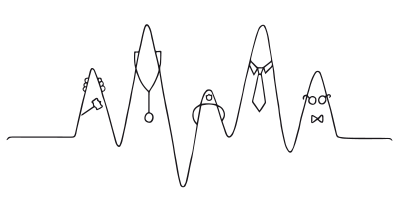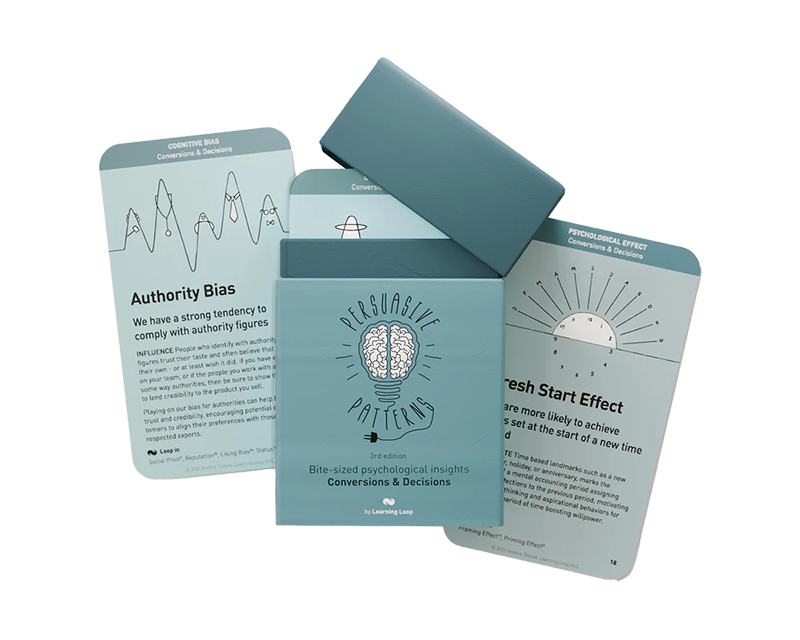Persuasive Patterns: Relation
Social Proof
We assume the actions of others in new or unfamiliar situations

Social Proof operates on the foundational human instinct to seek validation from peers and the broader community. In digital products, Social Proof is often represented through user testimonials, ratings, or indicators of popular choice. This pattern plays on our natural tendency to believe that actions performed by a majority are generally correct, or at the very least, safer choices.
Imagine walking through a bustling city center, looking for a place to grab lunch. You come across two food stalls side by side. One has a long queue of people waiting, while the other is almost empty. Without knowing anything else about the two stalls, you might instinctively be drawn to the one with the queue. The reasoning is simple: if so many people are choosing that stall, the food must be good. This attraction to the busier stall is an example of Social Proof in action. We often rely on the choices of others, assuming they have made an informed decision, especially when we are uncertain.
Now, think about searching for a software tool online. You land on two websites, both offering similar functionalities. One showcases testimonials from well-known companies and displays a counter indicating that over 10,000 businesses use their tool and showcase logos of prominnent and well respected customers. The other website provides no such indications. Even if you hadn’t heard of any of the companies providing testimonials, their mere presence might give you more confidence in the product. The endorsements and the large number of users serve as a digital “queue” that can sway your decision, much like the queue at the food stall. This is the power of Social Proof, seamlessly integrated into a digital product’s design to instill trust and influence decision-making.
The study
In the 1950s, renowned psychologist Solomon Asch conducted a simple yet powerful experiment that laid the foundation for our understanding of Social Proof. Participants were shown a line and then asked to identify which of three other lines matched its length. The answer was clear, but there was a catch: each participant was surrounded by actors who intentionally chose the wrong line. Astoundingly, about 75% of participants conformed to the group’s incorrect choice at least once, illustrating the immense power peer influence can have on our decisions.
Asch, S. E. (1951). Effects of group pressure upon the modification and distortion of judgments. Journal of Abnormal and Social Psychology, 46(2), 190-200.
The underlying principle of Social Proof is the human tendency to view a behavior as more appropriate or correct when we see others performing it. This is particularly pronounced in situations of uncertainty, where we look to others as a guide for our own actions. The idea is that if many people are doing something or believe in a particular concept, it must be valid or beneficial.
As humans, we have a common tendency to adopt the opinions and follow the behaviors of the majority to feel safer and to avoid conflict.
Social Proof establishes the norm others follow through experts, celebrities, the crowd, friends, or similar users. Communicate Social Proof testimonials, expert quotations, related actions by friends, or statistics like number of views, followers, or comments to encourage desired behaviors.
The actions of those around us are important when we decide what constitutes correct behavior. Whether it is to choose between two restaurants, to litter on the street, how fast to drive in a certain stretch on the highway, or which youtube video to watch first, we look to those around us to determine the correct answer.
Assuming that those around us are behaving normally, we will make fewer mistakes by acting in accord with social evidence than contrary to it. Acting in accord with social evidence is a shortcut to correct behavior and an often good decision.
Social proof is so effective as most of us would rather imitate that initiate. Independent thought requires expensive brain energy, why we often resort to short-cutting our thought processes where we can.
Your audience will judge your propositions as being more true and acceptable if you succeed to establish your credibility. Especially if your product is new, it’s critical to establish credibility with potential customers
Designing products with Social Proof
The triad of rhetoric, with its roots in Aristotle’s ancient rhetorics, provides a robust framework for the application of Social Proof. By understanding and applying these principles, designers and strategists can craft more compelling, ethical, and effective experiences.
-
Logos – appealing to facts and logic
The first pillar of rhetoric emphasizes the use of logical arguments and facts. Within the context of Social Proof, this translates to the presentation of quantifiable evidence that supports a proposition or claim. For instance, community sites often display numbers to showcase the popularity of content: “8 people liked this”, “434 viewed this image”, or “this blog post has 12 comments”. Such numbers provide immediate, objective evidence of a consensus, nudging users towards certain behaviors.A classic example is the pricing page, where a particular subscription plan, often labeled as the “most popular plan”, stands out. This strategy aims to alleviate the user’s indecision, subtly pointing them towards a preferred choice.
- Pathos – appealing to emotions
While logic appeals to the intellect, emotions target the heart, influencing judgments and decisions. Social Proof, when combined with emotional cues, can amplify the persuasive effect. Testimonials are a prime example. By showcasing stories or feedback from satisfied customers, especially those who resonate emotionally with potential users, businesses can create a deeper connection. For those on the fence about a product’s value, a heartfelt testimonial from a pleased customer can tip the balance. - Ethos – appealing to ethics, moral, and character
The final pillar of rhetoric rests on ethos, or the appeal to ethical character. Establishing credibility and trustworthiness is paramount in persuasion. In the digital world, users are more inclined to heed recommendations or adopt behaviors if they perceive the source to be credible. Role models, or influential figures that the audience respects, play a pivotal role here. Understanding who the target audience admires or relates to can lead to more effective Social Proof. The authority of industry experts, endorsements from celebrities, or simply the sheer volume of similar users can all drive desired behaviors.
A few specific touches can either strengthen the power of social proof or weaken it.
- Enabler: Identification of group with self
People are more likely to conform to a group’s behavior if they perceive themselves belonging to the same or similar group than if they do not identify with the group. - Barrier: Special knowledge
People are less likely to conform to a group’s behavior if they perceive themselves as better advised about a situation than the surrounding group. - Barrier: Identification with authority
People are less likely to conform to a group’s behavior if they perceive themselves as a relevant authority figure in the situation. Perceived authority often happens when people have special training or knowledge that allows them to draw such conclusions.
Ethical recommendations
While it’s tempting to amplify or even fabricate endorsements, such practices can backfire significantly. Transparency and authenticity are paramount. Misrepresentation, such as using fake testimonials or artificially inflating user numbers, can erode consumer trust, leading to long-term damage that might be irreparable. It’s always recommended to use genuine endorsements and provide accurate metrics when leveraging Social Proof.
- Be transparent
Always be clear and honest about the source of your social proof. If a testimonial is from a paid endorser or a partner, disclose that information. - Balanced representation
Allow both positive and negative reviews to be visible. Users appreciate transparency, and a mix of reviews can actually enhance credibility. It shows that the feedback is genuine and not curated. - Regular updates
Ensure that testimonials, user counts, and other social proof elements are regularly updated. Outdated social proof can be misleading. - Avoid Manipulation
Never force or incentivize users to provide positive feedback or reviews. Authentic, voluntary feedback is more valuable and ethical. - User Consent
If showcasing user-generated content or specific user reviews as a form of social proof, always seek permission from the original creators or reviewers.
Real life Social Proof examples
AirBnb
Host profiles often highlight the number of reviews and their average rating. This gives potential guests confidence in the quality of the accommodation.
Amazon
Product listings on Amazon prominently display user reviews and ratings, often influencing purchasing decisions.
Dropbox
In its early stages, Dropbox showcased testimonials and the number of users to instill confidence in potential new users.
Trigger Questions
- How can I showcase the choices and opinions of a majority to guide users towards a desired action?
- Which endorsements or testimonials will resonate most with my target audience and inspire confidence?
- How can I use numbers (e.g., user counts, ratings) to provide tangible evidence of popularity or trustworthiness?
- Am I ensuring that all displayed feedback or endorsements are genuine, unbiased, and up-to-date?
- How can I emphasize the relatability of the group providing the social proof to my target users?
- How can I present social proof in a way that's effective without overwhelming or pressuring the user?
Pairings
Social Proof + Authority Bias
Combining the influence of peers with the authority of experts can significantly boost the credibility of a product or service. For instance, if a skincare product is not only raved about by customers but also recommended by dermatologists, it gains dual validation. Real-world examples exist in plenty for skincare brands, which are frequently endorsed both by regular users and dermatologists.

We assume the actions of others in new or unfamiliar situations

We have a strong tendency to comply with authority figures
Social Proof + Commitment & Consistency
People are more likely to take action if they see others doing the same, especially if they’ve previously expressed an interest or made a smaller commitment. For instance, if users see that many people have signed a petition (Social Proof), they might be more likely to join if they had previously expressed support for the cause (Commitment & Consistency). An example here is the platform “Change.org,” where users can see the number of signatures a petition has, making them more likely to sign if they’ve shown prior interest.

We assume the actions of others in new or unfamiliar situations

We want to appear consistent with our stated beliefs and prior actions
Social Proof + Scarcity Bias
The combination of these patterns can be particularly persuasive. When users see others buying a product (Social Proof) and also learn that there’s a limited quantity left (Scarcity), it can urge a quicker purchase decision. E-commerce platforms, like Amazon, often display messages such as “Only 3 items left in stock” alongside high product ratings to induce urgency while showcasing popularity.

We assume the actions of others in new or unfamiliar situations

We value something more when it is in short supply
A brainstorming tool packed with tactics from psychology that will help you increase conversions and drive decisions. presented in a manner easily referenced and used as a brainstorming tool.
Get your deck!- Influence: The Psychology of Persuasion by Cialdini
- Effects of group pressure upon the modification and distortion of judgments by Asch
- Social Proof at The Decision Lab
- APA PsycNet
- Cialdini, R. B. (2006). Influence: The psychology of persuasion. Harper Collins.
- Asch, S. E. (1951). Effects of group pressure upon the modification and distortion of judgments. Journal of Abnormal and Social Psychology, 46(2), 190-200.
- Newman, E. J., Garry, M., Bernstein, D. M., Kantner, J., & Lindsay, D. S. (2012). Nonprobative photographs (or words) inflate truthiness. Psychonomic bulletin & review, 19(5), 969–974.
- Berger, J. (2011). Contagious: How to build word of mouth in the digital age. Simon and Schuster.
- Kahneman, D. (2011). Thinking, fast and slow. Macmillan.
- Tversky, A., & Kahneman, D. (1974). Judgment under uncertainty: Heuristics and biases. Science, 185(4157), 1124-1131.
- Bandura, A. (1977). Social learning theory. Prentice Hall.
- Fredrickson, B. L. (2001). The role of positive emotions in positive psychology: The broaden-and-build theory of positive emotions. American Psychologist, 56(3), 218-226.
